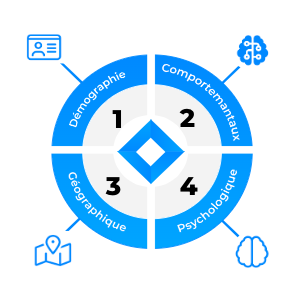At the dawn of the cookieless era, the digital marketing landscape is undergoing a radical transformation. Growing concerns about privacy and changing regulations have prompted industry players to rethink their data collection and advertising strategies. So this is the perfect opportunity to revolutionise your digital marketing!
In this context, several approaches are emerging: contextual targeting and semantic targeting. At the same time, Google’s evolution, with the end of third-party cookies and the introduction of the Privacy Sandbox, offers a new path for privacy-friendly digital marketing.
It’s not easy to find your way around this new cookieless era, which is why we’ve brought together the most relevant schemes to help you see things more clearly, in our article!
Google and the end of third party cookies
Google has announced the end of thris-party cookies in its browser by 2024, causing an earthquake in digital marketing. The decision follows a growing awareness of privacy concerns and the collection of users’ personal data.
However, Google is not leaving advertisers in the lurch and is offering an alternative called Google Privacy Sandbox!
Privacy Sandbox: Google’s answer to the cookieless world
The end of third-party cookies means that advertisers will no longer be able to directly track users across different websites to target their ads. However, Google’s Privacy Sandbox introduces privacy-based targeting techniques that preserve users’ anonymity while allowing them to deliver targeted advertising.
Google’s Privacy Sandbox is based on the use of techniques for processing data on the user’s device, rather than sending it to remote servers. These approaches, which focus on confidentiality and the protection of user data, mark an important turning point in the online marketing industry.
However, marketers will have to adapt to these new segmentation methods, which focus more on the context and aggregate users’ behavior, rather than on individual data.
After years of relying on thirs-party cookies provided by Chrome, cookieless marketing is proving to be a real challenge!
Yet this is a real opportunity to do digital marketing differently, while respecting users’ privacy rights and guaranteering a secure online experience.
SSO: a solution form the cookieless world
In today’s digital world, Single Sign-On (SSO) is emerging as an effective solution for simplifying the user experience while strengthening data security.
SSO allows users to access multiple applications and websites using a single set of login credentials. This approach reduces the need to remember multiple passwords, making life much easier for users.
From a marketing perspective, SSO also offers new opportunities to help you optimise your advertising campaigns and understand the behavior of your users.
With SSO, users can voluntarily share their credentials with thirs-party platforms, providing access to valuable demographic and behavioral data.
By using this information, you can personalise your advertising according to users’ preferences nd interests, creating more relevant and attractive messages!

targeted data: the future cookieless through segmentation
In the cookieless era, where user privacy has become a major concern, contextual targeting and semantic targeting enable data to be segmented by analysing the content of a web page and the associated keywords. This method is making a comeback in response to the disappearance of thirs-pary cookies.
Contextual targeting
Contextual targeting focuses on the content of a web page and the contextual information that surrounds it.
By analysing the keywords, themes and general context of a page, you can place your adverts in a relevant way, ensuring that they reach an audience with an affinity with the page’s content.
This approach enables companies to maintain a degree of advertising effectiveness while respecting users’ privacy concerns, as no personal data is required for targeting. This makes it an indispensable strategy today.

Semantic targeting
Semantic targeting takes into account the meaning and intent of the words used in online content. Thanks to sophisticated machine learning algorithms, you can analyse the semantic context of a text and understand the nuances and associations between the words used.
This enables advertisers to target their advertising based on key concepts and users’ search intentions, rather than relying solely on cookies and personal data.
In this way, semantic targeting offers a more subtle and precise approach to reaching users interested in a specific subject, while preserving the confidentiality of their data.
Beyond third-party cookies: the power of first-party data
As restrictions on thirs-party cookie increase, advertisers need to rethink their data collection strategies to continue to target their audiences effectively. This is where the collection of first-party data takes on its full meaning.
By focusing on information provided directly by users, you can build a relationship of trust and obtain valuable data for personalising the user experience. First-party data collection offers a clear advantage, as it is based on consent and provides a better understanding of consumer preferences, behaviors and needs.
First-party data collection is therefore an essential strategy in this cookieless environment, enabling you to continue to collect valuable data directly from users, while strengthening your relationship with them.
Conclusion
In conclusion, the advent of the cookieless world has propelled online marketing into an era of change and adaptation.
Contextual targeting and semantic targeting offer alternative approaches to reaching consumers without the use of third-party cookies, by focusing on the relevance of content and the meaning of words.
Google’s initiative to put an end to third-party cookies and the introduction of the Privacy Sandbox offer you new opportunities to deliver targeted advertising while preserving the confidentiality of your users.
However, it is crucial that these developments are accompanied by an ethical approach that respects privacy. Not only to comply with the new regulations, but also to strengthen the bond with its consumers.
You’re now ready for the cookieless era! Now it’s up to you to revolutionise your digital marketing strategy.








